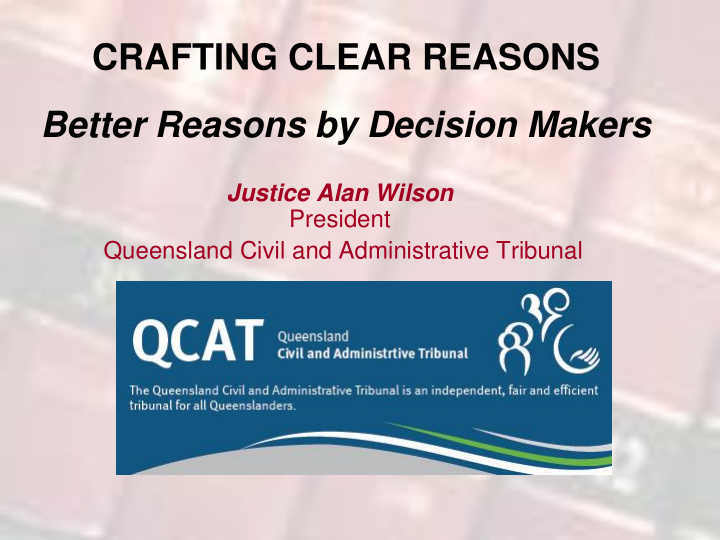



CRAFTING CLEAR REASONS Better Reasons by Decision Makers Justice Alan Wilson President Queensland Civil and Administrative Tribunal
WELL-WRITTEN REASONS ARE PERSUASIVE The key is to write reasons that can be understood: reasons which expose, in language that is as simple and straightforward as the matter allows, how and why the decision-maker came to the decision; and, by that simplicity and clarity, allow the reader to see and understand what has happened – and, at best, why it is right.
CLEAR, CONCISE REASONS This is a determination under s 75 of the Domestic Animal (Dogs, Cats and Poultry) Act 1995. Subject owns residential property at Smith St, Greenville, whereon have been kept, at diverse times and dates, up to 11 dogs. Various neighbours have lodged adverse reports concerning behaviour of said dogs. Council has a substantive log of complaints about said dogs causing injury to other ratepayers and creating undue noise and is thereby obligated to have said dogs destroyed. Ms Brown owns a residential property as Smith Street, Greenville. Council has received reports and complaints about her dogs, which it has investigated. The law has limits on the number of dogs a householder can keep, and also places responsibility upon an owner to ensure they do not cause harm or disturbance. This decision concerns Ms Brown’s dogs, Council’s investigations into complaints about them, and the conclusions it has reached about what should be done.
CLEAR, CONCISE REASONS Applicant Jones seeks issue of positive Notice under Protection of Young People Act 1998. Applicant has several relevant convictions involving physical assaults. Section 175 of said Act requires that certain matters be addressed in an application of this type, such matters are addressed as follows… Mr Jones seeks what is called a Blue Card which would, under the Protection of Young People Act 1998, allow him to pursue his interest in training children in gymnastics. He has, however, some previous convictions for assault and the law requires that I must consider them in deciding his application. The way this is done is, firstly, to decide whether any of the convictions is what the law calls ‘serious’. If that is the case, the law makes it quite difficult for Mr Jones to obtain a Blue Card. Even if it that is not the position, however, I must still consider the nature of each offence and decide whether the case is what the law calls an ‘exceptional’ one – meaning that, although the offending is not ‘serious’, it is still so important and relevant that I should refuse to issue a Blue Card.
EXPLAIN THE STATUTE Summarising the law, and putting it into accessible language, serves two useful purposes: it helps you in the work of shaping and explaining your decision, because you will be forced to focus on its meaning and intent during the work of ‘re - framing’ it into your own words; and, it helps the recipient of the decision – usually, not a lawyer, and generally inexperienced in the jurisdiction – understand the law that affects them.
KNOWN PITFALLS The most common, recurring errors involve mistakes about evidence, and a failure to ‘expose’ the process of reasoning – that is, leaving a gap in the step between recitations of the relevant facts and law, and the actual decision. The reader must be able to see and understand the why of your decision – an exercise which requires the decision-maker to explain, in a way that can be understood, that the application of this law to these findings of fact = this conclusion.
USING STRUCTURE TO IMPROVE QUALITY What is to be decided? What are the relevant facts? What is the law to be applied? What happens when that law is applied to those facts? What decision flows logically from that exercise?
USING STRUCTURE TO IMPROVE QUALITY Mr Smith is a fisherman, with a licence to catch mullet south of Moreton Island. The licence requires him to catch at least 500kg each year, and if he does not the Department may withdraw it. Mr Smith only caught 170kg last year. The Department wants to withdraw his licence and can do so unless, under the Fisheries Regulation 1999, he can show a good reason that should not happen. One reason recognised in the Regulation is that to do so would cause him hardship. The burden of proving hardship rests on him. He says he was too ill to fish for much of the year but, despite being asked several times over some months to produce a doctor’s report or other evidence of his illness, he has not done so. That is the only reason he has put forward. I have to decide if his mullet licence should be withdrawn.
CREDIT ISSUES, DISPUTES OF FACT Is it necessary to make a finding? What is the standard of proof? Can a finding be made on the available evidence?
CREDIT ISSUES, DISPUTES OF FACT Which evidence has probative force? Where is the weight of the evidence? Is a finding of x reasonable in light of the answers to the first two questions?
Recommend
More recommend